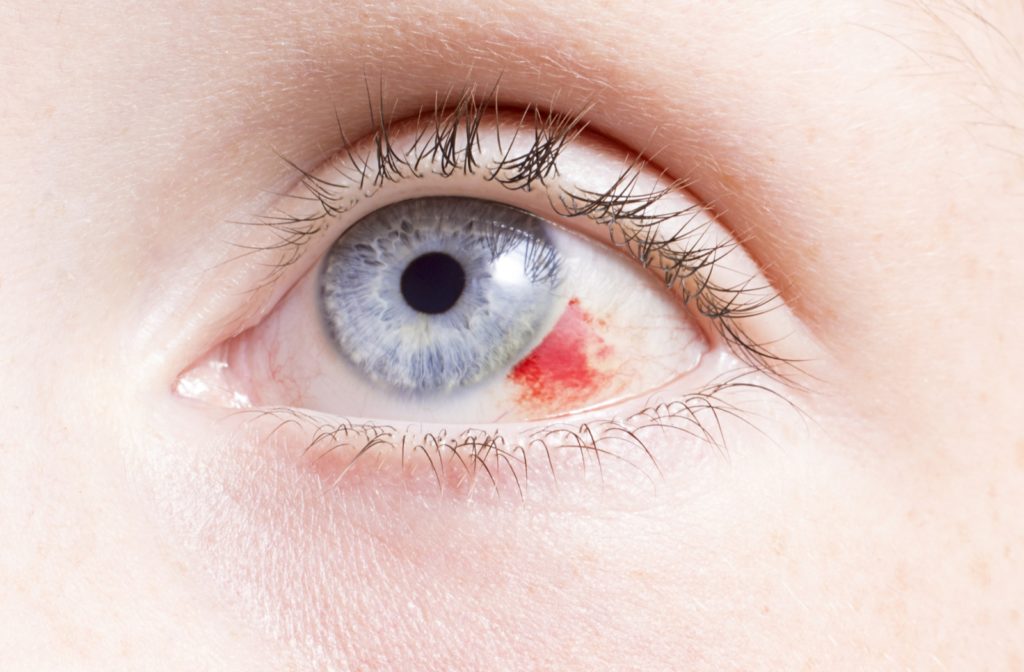Bright red patches in your eyes can be an alarming sight, but don’t panic.
You may have a subconjunctival hemorrhage, otherwise known as broken blood vessels in the eye. Fortunately, broken blood vessels in your eyes are usually nothing to worry about. Understanding what causes blood vessels to break, pop, and burst can help prevent future hemorrhages from occurring.
What is a Subconjunctival Hemorrhage?
A subconjunctival hemorrhage refers to broken blood vessels in the eye that cause red patches on the sclera (white part of your eye). While it may look scary, a subconjunctival hemorrhage is usually harmless.
The conjunctiva is the clear membrane that covers your eye and is home to many tiny blood vessels. When blood gets trapped under this membrane, it’s referred to as subconjunctival. Even though there’s blood, it shouldn’t affect your vision.
Causes of Broken Blood Vessels in the Eye
Blood vessels in your eye can break or “pop” for many different reasons. Common causes include:
- Powerful coughing/sneezing
- Vomiting or dry heaving
- Straining during physical activity
- Rubbing your eyes too hard
- Eye surgery
- Injury or puncture to the eye
If you have diabetes, hypertension (high blood pressure), or a blood-clotting disorder, you may be more prone to subconjunctival hemorrhages. Certain medications that act as blood thinners, like aspirin, can also contribute to an increased risk of broken blood vessels in the eye.
Symptoms
Visible red spots or patches on your sclera are the main indicator of a subconjunctival hemorrhage. You may feel some mild itchiness on your affected eye, but nothing more.
If you experience any pain or vision changes, contact your doctor.
Healing Broken Blood Vessels
Broken blood vessels in the eye should resolve naturally over a 1 – 2 week period. You can use eye drops to help soothe any itchiness you may feel during this time.
Being gentle with your eyes can help prevent broken blood vessels. Try to avoid rubbing your eyes if you can. You may not always be able to prevent subconjunctival hemorrhages, especially when coughing, sneezing, or vomiting.
Just know that broken blood vessels in the eye do happen and are usually no cause for concern.

Recurring Subconjunctival Hemorrhages
If you experience recurring subconjunctival hemorrhages, it could be a symptom of an underlying condition or issue.
For example, some people have experienced recurring subconjunctival hemorrhages as a result of improper contact lens insertion. Touching your own eye can be unnerving, so some people use tools to help put in and take out their lenses. It can be harder to gauge the right pressure with these tools which can result in frequent subconjunctival hemorrhaging.
This is why it’s important to follow your optometrist’s instructions when using contact lenses. Don’t use tweezers or any tools unless specifically directed.
Vascular Diseases
Recurring subconjunctival hemorrhages (SCH) may be a sign of vascular disease. Vascular diseases weaken blood vessels all through the body, making them more susceptible to breakage. Some examples of this include uncontrolled hypertension, arteriosclerosis, and diabetes.
Conjunctivochalasis
Conjunctivochalasis is a condition where the conjunctiva is extremely loose, which can be a result of the aging process. This condition can be asymptomatic, meaning it might be overlooked during initial exams. However, it can cause more frequent tearing in the eye, resulting in recurring SCHs.
Ocular Adnexal Tumors
Recurring SCHs may be an early sign of a tumour, which can indicate many things. This is why it’s important to notify your doctor if you have recurrent SCHs.
Is It Something Else?
The biggest indicator that you have broken blood vessels in your eye is how the red spots appear. Broken blood vessels in the eyes form in bright red patches. Some redness may look like broken blood vessels, but it’s really something else.
As we know, broken blood vessels may feel slightly scratchy, but otherwise shouldn’t affect your eyes. Understanding your symptoms can help you determine if it’s something serious.
Conjunctivitis
Conjunctivitis (pink eye) occurs when the conjunctiva becomes inflamed. The blood vessels become more visible, making the whites of the eye appear pink or red. Symptoms of pink eye include:
- Pink/red sclera in one or both eyes
- Itchiness in one or both eyes
- Discharge from affected eyes
- Watery eyes
Hay Fever
Hay fever (allergic rhinitis) is an allergic reaction to allergens, such as dust or pollen. Fortunately, hay fever is very treatable, but it can be annoying. The symptoms of hay fever include:
- Sinus congestion
- Reddish, itchy eyes
- Profuse tearing
- Sneezing/coughing
- Itchy nose & throat
- Nasal dripping
- Fatigue
Iritis
Iritis (anterior uveitis) occurs when the iris (ring around pupil) becomes inflamed. Iritis can develop quickly, and can lead to vision loss if left untreated. Symptoms of iritis include:
- Redness in one or both eyes
- Discomfort/achiness
- Light sensitivity
- Reduced vision
Keratitis
Keratitis occurs when the cornea is inflamed. It can be related to an infection or injury. If left untreated, keratitis can lead to vision loss. Symptoms of keratitis include:
- Redness in one or both eyes
- Tears/discharge
- Blurred/decreased vision
- Light sensitivity
- Pain in/around affected eye
- Feeling something in your eye
When to See a Doctor
If you notice broken blood vessels in your eyes on a recurring basis, you experience additional symptoms like pain or vision changes, or the broken blood vessels don’t heal after 3 – 4 weeks, contact your doctor.
The best way to maintain healthy eyes is by scheduling and attending regular eye exams. Contact our team today to book in or get answers to any questions you may have about your eyes. Our team is happy to help.



